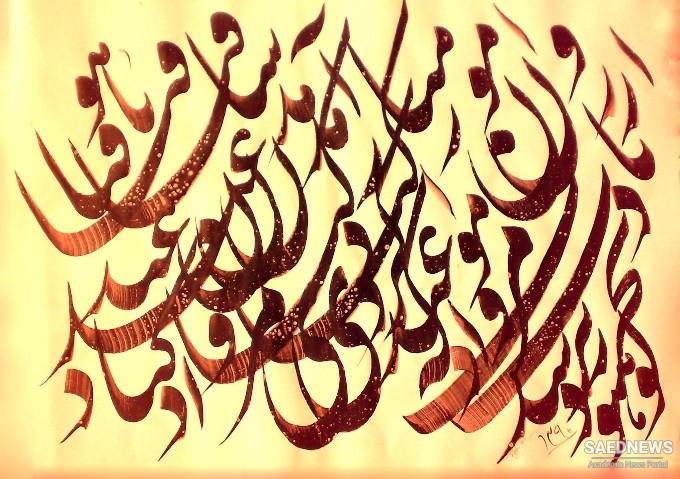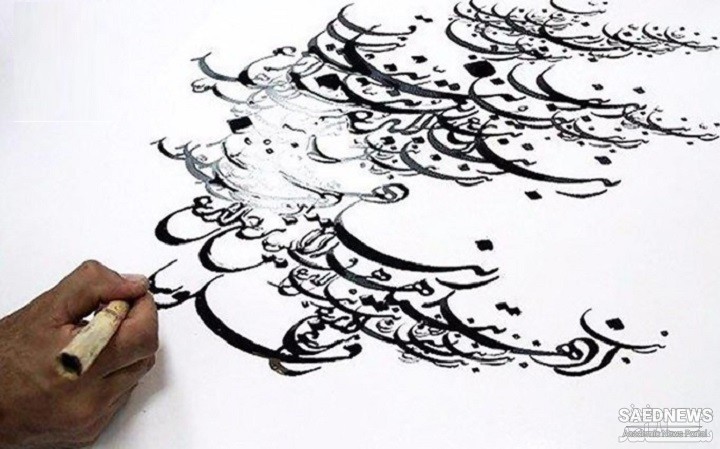It was also crystallized in the ink with which the Divine Pen (al-Qalam) wrote the realities of all things (al-haqa'iq) upon the Guarded Tablet (al-Lawh> alMahfuz), upon the pages of that archetypal book that is none other than the Quran as the 'Mother of Books' (Umm al-kitab), the 'Book' containing the inexhaustible possibilities of Divine Creativity. The Holy Book itself attests to this 'ink' in the verse, 'If all the trees in the earth were pens, and if the sea eked out by seven seas more were ink, the Words of God could not be written out unto their end.' (XXXI; 27 trans. M. Lings).
In the same way that the psalmody of the Noble Quran as the sonoral sacred art of Islam par excellence is the origin of the traditional sonoral arts, so is the art of calligraphy, which reflects on the earthly plane the writing of His Word upon the Guarded Tablet, the origin of the plastic arts. Quranic calligraphy issues at once from the Islamic revelation and represents the response of the soul of the Islamic peoples to the Divine Message. The points traced by the Divine Pen created at once the celestial archetype of Quranic calligraphy as well as the lines and volumes of which the cosmic order is constituted and from which issues not only natural space, but also the space of Islamic architecture.

In the mystery of the Point, represented by the diacritical point under the first letter which opens the Noble Quran, namely the letter ba', is to be found the principle of both Islamic calligraphy and Islamic architecture, the principle of both the sonoral and plastic arts, the root of both of which is to be found in the Sacred Book. The points and lines of Islamic calligraphy with their inexhaustible diversity of forms and rhythms are related to that Supreme Divine Precinct at whose centre resides the first Point which is none other than His Exalted Word. The Master of Illumination, Shihab al-Din Suhrawardi, begins one of his prayers with these words: 'O Master of the Supreme Circle from which issue all circles, with which terminate all lines, and from which is manifested the First Point which is Thy Exalted Word cast upon Thy Universal Form.'
The Guarded Tablet contains the archetypes of all earthly forms and more particularly of traditional Quranic calligraphy, all of whose styles are made possible by, and reflect, the sacred character of the Revealed Book. Islamic calligraphy is the visual embodiment of the crystallization of the spiritual realities (al-haqa'iq) contained in the Islamic revelation. This calligraphy provides the external dress for the Word of God in the visible world but this art remains wedded to the world of the spirit, for according to the traditional Islamic saying, 'Calligraphy is the geometry of the Spirit'.
The letters, words and verses of the Quran are not just elements of a written language but beings or personalities for which the calligraphic form is the physical and visual vessel. Through the writing and reading of these letters, words, and verses, man enters into contact with these beings and talismans which have come ultimately from the far 'other' shore of universal existence to guide man back to the abode of the One. For him who understands the significance of the Quran in both its spoken and written form, 'it is easy to understand the capital part played in the life of the Moslem by those sublime wordsthe verses of the Quran; they are not merely sentences which transmit thoughts, but are in a way, beings, powers or talismans.'
Inasmuch as there resides a Divine Presence in the text of the Quran, calligraphy as the visible embodiment of the Divine Word aids the Muslim in penetrating and being penetrated by that Presence in accordance with the spiritual capabilities of each person. The sacred art of calligraphy aids man to pierce through the veil of material existence so as to be able to gain access to that barakah that resides within the Divine Word and to 'taste' the reality of the spiritual world. 'Calligraphy and illumination are as it were compensations for such contingencies as ink and paper, a "step up" which makes it possible, in a flash of wonderment, to approach more nearly and penetrate more deeply the Divine substance of the Quranic text, and thus to receive a "taste", each soul according to its capacity, of the Infinite and the Eternal.'

Although calligraphy has developed in numerous forms and has embraced functions and domains not directly related to the text of the Quran, something of this principial wedding between calligraphy, which began in a purely Quranic context, and the spiritual substance of the Quran has survived within all aspects of traditional Islamic calligraphy. It has come to occupy a position of special privilege in Islam to the extent that it could be called the progenitor of the traditional Islamic visual arts and the most characteristic feature of the visible aspect of Islamic civilization.6 It has become identified over the centuries with culture itself, good calligraphy being taken as a sign of a cultured man and a disciplined mind and soul as well as hand. Calligraphy has continued to be the central visual art with its numerous applications ranging from architecture to poetry. Calligraphy is the basic art of creation of points and lines in an endless variety of forms and rhythms which never cease to bring about recollection (tidhkar or dhikr) of the Primordial Act of the Divine Pen for those who are capable of contemplating in forms the trace of the Formless.


 Zarathushtra yearns to see Ahura Mazda
Zarathushtra yearns to see Ahura Mazda














































